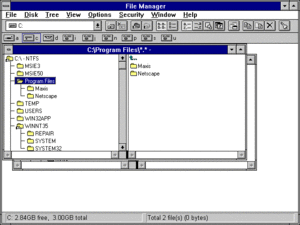File Manager (Windows)
| A component of Microsoft Windows | |
|---|---|
|
File Manager in Windows NT 3.5 displaying a folder and the contents of partition C:. | |
| Details | |
| Type | Shell |
| Included with | Windows 3.0 to Windows NT 4.0 and Windows Me |
| Replaces | MS-DOS Executive |
| Replaced by | Windows Explorer |
| Related components | |
| Program Manager | |
File Manager is a file manager program bundled with releases of Microsoft Windows between 1990 and 1999.[1] It was a single-instance graphical interface, replacing the command-line interface of MS-DOS, to manage files (copy, move, open, delete, search, etc.). Although File Manager was included in Windows 95 and Windows NT 4.0 and some later versions, Windows Explorer was introduced and used as the primary file manager, with file management via a 2-pane view different from File Manager's, and a single-pane view obtained by clicking a "My Computer" icon.
Overview
The program's interface showed a list of directories on the left hand panel, and a list of the current directory's contents on the right hand panel. File Manager allowed a user to create, rename, move, print, copy, search for, and delete files and directories, as well as to set permissions (attributes) such as archive, read-only, hidden or system, and to associate file types with programs. Also available were tools to label and format disks, manage folders for file sharing and to connect and disconnect from a network drive. On Windows NT systems it was also possible to set ACLs on files and folders on NTFS partitions through the shell32 security configuration dialog (also used by Explorer and other Windows file managers). On NTFS drives, individual files or entire folders could be compressed or expanded.
The Windows NT version of File Manager allows users to change directories, files, local, network and user permissions.
From Windows 95 and Windows NT 4.0 onward, File Manager was superseded by Windows Explorer. However, the WINFILE.EXE program file was still included with Windows 95, Windows 98 and Windows Me (16-bit executable), and Windows NT 4.0 (32-bit executable). The last 32-bit WINFILE.EXE build (4.0.1381.318) was distributed as part of Windows NT 4.0 Service Pack 6a (SP6a). The last 16-bit WINFILE.EXE build (4.90.3000) was distributed as part of Windows Me operating system.
Ian Ellison-Taylor was the shell developer on the Windows 3.1 team responsible for File Manager and Print Manager.[2]
Versions
16-bit
The original version of File Manager was a 16-bit program that supported the 8.3 file names that were in use at the time.
It did not support the extended file names that became available in Windows 95 - including long file names and file names containing spaces. Instead, it would display only the first six characters followed by a tilde character "~" and a number, usually 1. More numbers (2, 3, and so on) were added after the tilde if more than one file name with same first characters existed in the same directory.
The 16-bit version distributed with Windows 3.1x and Windows for Workgroups 3.1x installations had a Y2K issue due to lexicographic correlation between date representation and the ASCII character set; colons and semicolons replaced what should have been '2000'. Microsoft issued corrected binaries for all Windows 3.1x environments.[3]
Windows NT
File Manager was rewritten as a 32-bit program for Windows NT. This new version correctly handled long file names as well as NTFS file systems. It was included with Windows NT 3.1, 3.5, 3.51, and 4.0.
See also
References
- ↑ Microsoft (2006-03-07). "Windows Desktop Products History". Windows History. Microsoft. Retrieved 2006-08-19.
- ↑ Microsoft (2007-02-20). "Dr Sneath and Ian Ellison-Taylor: Windows History". Microsoft. Retrieved 2007-03-10.
- ↑ Microsoft (2006-08-22). "File Manager Shows Garbled Date for Year 2000 or Later". Microsoft Help and Support. Microsoft. Retrieved 2006-08-18.

.svg.png)